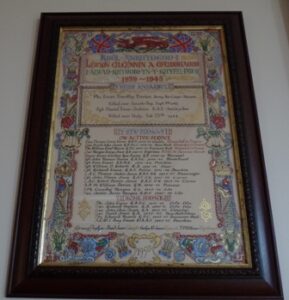Cilcennin is situated in the heart of the Aeron valley, five miles from Aberaeron, and a mile north-east of Ciliau Aeron. It was the scene of a slaughter committed, in 1210 by Rhys and Owain ab Grufydd, who, with three hundred men, defeated a superior body of English and Welsh troops, under the command of their uncle Maelgwyn. The memorial to the men of the area who fell during both world wars is located in Holy Trinity Churchyard, and is of pink granite, in the form of a symbolic broken cross. There are also several individual memorials within Holy Trinity Church, including an illuminated scroll for the parishioners who served during WW2, and one in Capel Sion.
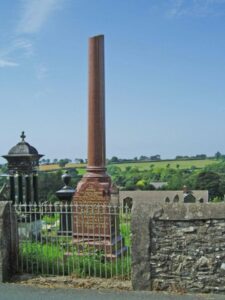
The Great War, 1914-1918
Evan Davies, Private, 202637, Welsh Regiment. Evan was born in 1892, the son of Evan and Elizabeth Davies, of Berllanfach, Cilcennin. He enlisted at Brecon into the army, and was posted to the 18th Battalion, Welsh Regiment. The battalion was raised in January 1915 as a Bantam Battalion and went to Porthcawl attached to 43rd Division, before moving to Prees Heath in July 1915, where it became attached to 119 Brigade, 40th Division. During June 1916 the Division landed in France, and fought at the Battle of the Ancre, remaining in the area over the winter. In March 1917 the Germans withdrew to their shortened line, called the Hindenburg Line, and the 40th Division were one of the Divisions that followed the withdrawal. Later in the year they took part in the Battle of Cambrai, playing an important role in the attack on Bourlon Wood. Evan was killed in action here on 24 November 1917. He was 25 years old, and is buried at Orival Wood Cemetery, Flesquieres, France.
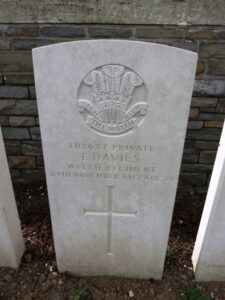
Isaac Evans, Private, 125761, Machine Gun Corps. Isaac was born in 1898, the son of Jenkin and Margaret Evans, of Soar, Cilcennin. His mother had been widowed by 1911, and Isaac went to live at Nantgaredig, near Carmarthen, with his sister Margaret and her husband David Samuel Roberts (see below). He enlisted in Carmarthen into the Monmouth Regiment, service number 47023. Isaac would have been a machine gunner, and when the Machine Gun Corps were formed in 1916, he transferred into the 6th Battalion, Machine Gun Corps, who formed part of the 6th Division. In the spring of 1918 the Division was one of those hit by the German Offensive on the Somme, which had been launched on 21 March, and the Division took part in the Battle of St Quentin. They were moved from the line, and went to Flanders to rest, but the following month the Germans launched another offensive on the Lys, and the Division fought during the Battle of Bailleul, and the First and Second Battles of Kemmel. Isaac was wounded near Kemmel, and died of wounds on 20 July 1918, aged 19. He is buried at Le Quesnoy Communal Cemetery.
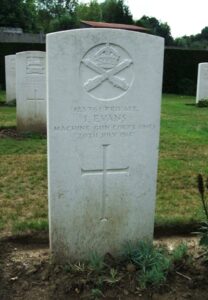
George Gibson, Private, M/279418, Army Service Corps. George was born at Cockshutt, near Ellesmere, Shropshire in 1893, the son of John and Ann Gibson. Prior to the war he resided with his wife, Sarah Ann Gibson, at Bontnewydd, Ciliau-Aeron. George served with the XVIII Corps Mechanical Transport, Army Service Corps. He would have been involved in moving supplies to the front for the infantry units in the front line. George was killed on 31 May 1918. He was 24 years old, and is buried at Ligny-St. Flochel British Cemetery, Averdoingt, France.
Ivor Jenkin Jones, Private, 37532, Royal Welsh Fusiliers. Ivor was the son of John and Margaret Jones, of Penwern Farm, Cilcennin. He worked as a clerk in The National Provincial Bank at Aberdovey prior to the war and enlisted there into the Royal Welsh Fusiliers on 18 December 1915. Ivor was posted to France 25 June 1916, joining the 16th Battalion, Royal Welsh Fusiliers. The battalion was attached to 115 Brigade, 38th (Welsh) Division, and Ivor joined up with them in time to take part in the attack on Mametz Wood. After suffering heavy casualties at Mametz, by August 1916 the Division had moved to positions at Boesinghe, north of Ypres. Ivor was shot in the shoulder here on 29 July 1917, when his battalion was moving into positions ready for the assault on Pilckem Ridge. He was evacuated home for treatment, before being sent back to France in January 1918, when he was posted to the 2nd Battalion, Royal Welsh Fusiliers. The battalion had taken part in almost every major action of the war, before becoming attached to 115 Brigade, 38th (Welsh) Division at Armentieres on 3 February 1918. During April the Division was moved South, taking up positions North of Albert, from where they weathered the storm of the coming months, until the war turned during the Battle of Amiens, on 8 August, 1918. The Germans had now lost the upper hand, and the British regained the lost ground on the Somme after an attack which began on 21 August, with the 38th Welsh in the midst of the attack during the Battle of Albert, and then moving east, where they fought at the Battle of Bapaume. Ivor was killed in action during the great advance, fighting at Sailly-Saillisel, on 3 September 1918. He was 22 years old, and is commemorated on the Vis-En-Artois Memorial, France.
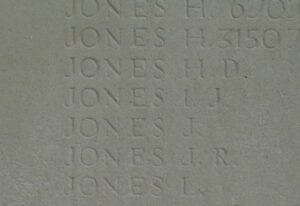
Jenkin Jones, Private, 52094, Cheshire Regiment. Jenkin was born at Cilcennin in 1898, the son of Benjamin and Eleanor Jones of Cefn Gaer. He worked as a milk carrier in London prior to the war and was underage when he enlisted there on 19 April 1915 into the Royal Welsh Fusiliers. He embarked for France to join the 1st RWF on 6 July 1916 but was transferred to the 13th Battalion, Cheshire Regiment, which was attached to 74 Brigade, 25th Division. The Division was on the Somme, and had suffered heavy casualties during its attack on 3 July near Thiepval. It remained on the Somme over the coming months, and Jenkin was killed here on 2 September 1916, aged 18. He has no known grave, and is commemorated on the Thiepval Memorial, France. There is a memorial to Jenkin at Henfynw Church.
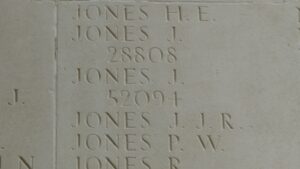
Charles Bernard Morland, Lieutenant Colonel, Welsh Regiment. Charles was born at Montreal, Canada on 12 November 1866. He was a career soldier, and was stationed at Pembroke Dock with the 2nd Welsh for several years, marrying Elma Alice Maud Abadam, a descendant of the Duke of Burgundy in 1894, and the couple set up home at Glanrhwdw, near Llangendeirne, Carmarthenshire. Charles had originally been commissioned into the Welsh Regiment in 1887, serving with them throughout the Boer War. At the outbreak of the Great War, Charles was given command of the 2nd Battalion, Welsh Regiment, which moved to France attached to 3 Brigade, 1st Division. The Division had fought at Mons, and in the retreat to the Marne, before pushing back the Germans to the Aisne, where they were stopped. It then moved north, taking up positions east of Ypres, on the Menin Road. The Germans had began to push towards the Channel Coast, to force France to capitulate, but between them and their goals lay the ancient City of Ypres, thinly held by the British Expeditionary Force. The gateway to Ypres was via the Menin Road, held by the 2nd Welsh, and a few other battalions, and on 31 October 1914, after a bloody days fighting, the First Battle of Ypres was won here by the British, saving France from disaster. Charles Morland was killed on 31 October 1914, aged 47, when the battalion was fighting a desperate action at Gheluvelt. (Around the same time a shell crashed into Hooge Chateau, where the Staff of the 1st and 2nd Divisions were stationed, killing the two Generals in Command.) Charles’ body was taken for burial in Ypres, where he rests today in Ypres Town Cemetery.
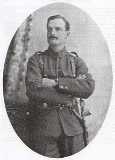
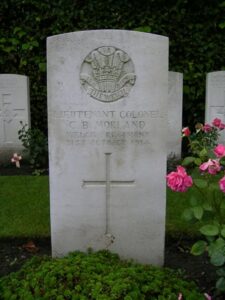
George Thomas Richardson, Private, 203218, Border Regiment. George was born at Manchester, the son of George and Margaret Elizabeth Richardson, of Red Bank, Cheetham. He had resided with Mrs Jones at Cilcennin prior to the war, working as a farm labourer. He returned to Manchester to enlist into the army on 27 April 1917. George was posted to France on 26 July 1917, joining the 1st Battalion, Border Regiment, which was in France attached to 87 Brigade, 29th Division. George would have seen his first major action during the Third Battle of Ypres. Later that year the Division moved to Cambrai, where it took part in the Battle of Cambrai in November and December 1917 before moving back to Flanders early in 1918. The German Spring Offensive hit the British on the Somme on 21 March 1918, and hit in Flanders just weeks later. The 29th Division fought at the desperate defensive battles of Estaires, Messines, Bailleul and Kemmel, before the war turned in favour of the Allies after a series of successes on the Somme in August. The Division then took part in the Offensive in Flanders from September 1918. George was killed in action near Outtersteene on 30 September 1918, aged 21. He has no known grave, and is commemorated on the Tyne Cot Memorial, Belgium.
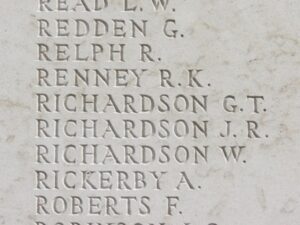
David Samuel Roberts, Private, 59843, Welsh Regiment. David was born at Penfordd, New Cross, in the Parish of Llanfihangel-y-Creuddyn on 24 November 1892, the son of William and Sarah Roberts. He married Margaret Ellen Evans, of Cilcennin, while he was working as a farm hand at Llanfarian on 30 April 1915 and lived at Soar, Cilcennin where their two children were born. In 1917 the family moved to Cross Hands, Nantgaredig and David worked as a collier at Tumble. He enlisted at Carmarthen into the 3rd Battalion, Welsh Regiment on 16 May 1917 and was posted to France on 16 October 1917, joining the 13th Battalion, Welsh Regiment, which was attached to 114 Brigade, 38th (Welsh) Division. David would have joined the Division after it had been withdrawn from Ypres, and moved to the quieter Armentieres sector to rebuild, before being transferred to the Somme in April 1918. On 21 August 1918 the Allied launched their great offensive, and the 38th Division advanced from its positions north of Albert, capturing Pozieres and Thiepval Ridges within days. Over the next few days the Division advanced across the old Somme battlefields towards Sailly-Saillisel. David was badly wounded on 4 September 1918, and died that same day, aged 27. His grave was lost on the battlefields, and he is commemorated on the Vis-en-Artois Memorial, France. Margaret returned to Soar, Cilcennin, after the war, with their young children, Mary and Willie. David is commemorated on three war memorials at Horeb Chapel, New Cross, at Cilcennin, and at Nantgaredig.
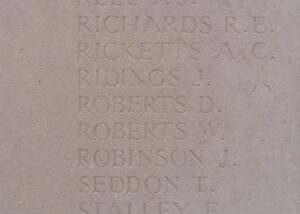
David Williams, Sergeant, 16984, King’s Own Scottish Borderers. David was born at Cilcennin in 1892, the son of David and Ellen Williams. By 1901 the family had moved to 12, Churchill Terrace, Cadoxton, Barry. David enlisted at Forfar into the 8th Battalion, King’s Own Scottish Borderers, which was attached to 46 Brigade, 15th (Scottish) Division, and landed in France with the battalion on 10 July 1915. The division moved to positions near Loos and on 25 September 1915 took part in the opening assault of the Battle of Loos. David was killed in action that day, on 25 September 1915, aged 24. He was seen to have been lying wounded on the ground when a German bullet struck him in the head. David has no known grave and is commemorated on the Loos Memorial, France. He does not appear to be commemorated locally.
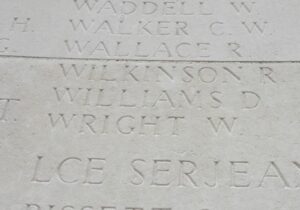
William Williams, Private, 54619, Machine Gun Corps. William was the son of Daniel Williams and Margaret Williams, of Newgate, Cilcennin. He served with the 60th Company, Machine Gun Corps, which was attached to the 20th (Light) Division. When the Battle of Loos was launched on 25 September 1915 the Division fought a diversionary attack towards Fromelles. Later that year they moved north, and fought at the Battle of Mount Sorrel alongside the Canadian Corps. They then fought through the Somme Offensive, and took part in the advance to the Hindenburg Line in March 1917. Later that year they fought at Third Ypres. William was killed at the Battle of Langemarck on 16 August 1917, aged 23. He is commemorated on the Tyne Cot Memorial, Belgium.
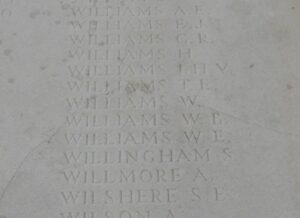
World War Two, 1939-1945
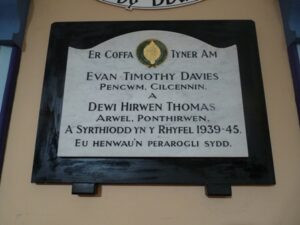
Evan Timothy Emos Davies, Private, 4209051, Parachute Regiment. Evan was the son of Michael Daniel and Ellen Davies, of Pencwm, Cilcennin. He originally served with the 10th Battalion, Royal Welsh Fusiliers, which was later transformed into the 6th Battalion, Parachute Regiment in August 1942. The battalion embarked for North Africa in April 1943, and took part in the amphibious landings on Italy in September 1943. Evan was aboard HMS Abdiel in Taranto Bay on 10 September 1943, when she struck a mine, and sank with the loss of 57 paratroopers. Evan was among the dead. He was 21 years old, and is buried at Bari War Cemetery, Italy.
Daniel Evan Jenkins, Sergeant (Air Gunner), 1420304, Royal Air Force Volunteer Reserve. Daniel was the son of John Jenkins and Mary Jane Jenkins (nee Jones), of Cilcennin, Ceredigion. His mother had been born and raised at Tainewydd, Llandyfaelog. Daniel served as an Air Gunner with 70 Squadron, Royal Air Force, which was after the outbreak of war was based in the Middle East, flying the Vickers Wellington. Daniel was an air gunner aboard Wellington LN918, which crashed with the loss of all her crew some five miles west of San Severo, Italy on 25 February 1944. He was 20 years old, and is buried at Bari War Cemetery, Italy alongside his fellow aircrew. He was a cousin to David John Jones, of Llandyfaelog, who was also killed during WW2.
Dewi Hirwen Thomas, Flying Officer, 117517, Royal Air Force Volunteer Reserve. Dewi was the son of Thomas and Mary Anne Thomas, of Llechryd. He had resided at Arwel, Ponthirwen prior to the war, and served with 169 Squadron, Royal Air Force as a pilot. 169 squadron was formed on 15 June 1942 at RAF Twinwood Farm as a tactical reconnaissance squadron, equipped with the North American Mustang. The squadron moved to RAF Duxford in December 1942 and began coastal reconnaissance and ground attack missions. Dewi was killed during one such raid on 30 April 1943. He was 22 years old, and is commemorated on the Runnymede Memorial, Surrey.
Cilcennin, Those Who Served, WW1

Cilcennin, Those Who Served, WW2
